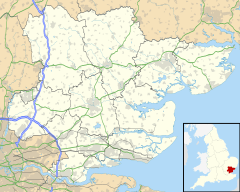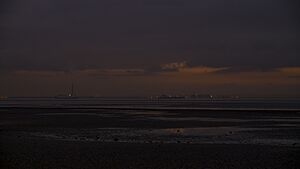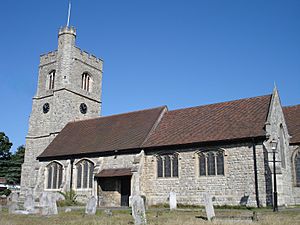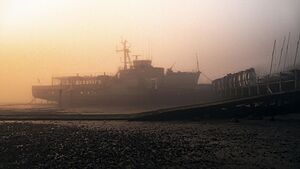Leigh-on-Sea facts for kids
Quick facts for kids Leigh-on-Sea |
|
|---|---|
 The Old Leigh waterfront at low tide, with cockle boats |
|
| Population | 22,509 (2011) |
| OS grid reference | TQ841859 |
| Civil parish |
|
| Unitary authority | |
| Ceremonial county | |
| Region | |
| Country | England |
| Sovereign state | United Kingdom |
| Post town | LEIGH-ON-SEA |
| Postcode district | SS9 |
| Dialling code | 01702 |
| Police | Essex |
| Fire | Essex |
| Ambulance | East of England |
| EU Parliament | East of England |
| UK Parliament | |
Leigh-on-Sea (pronounced lee), often just called Leigh, is a town and civil parish in the city of Southend-on-Sea, England. It's located in the county of Essex. In 2011, about 22,509 people lived there.
Contents
Exploring Leigh-on-Sea's Location

Leigh-on-Sea sits on the northern side of the Thames Estuary. This is where the River Thames meets the sea. It's only a few miles from the open North Sea to the east and the Kent coast to the south.
The town's coast has a special nature reserve called Two Tree Island. There's also a beach right in the middle of town, next to Bell Wharf. When the tide is low, you can see wide areas of mud flats and small waterways called creeks. These stretch out towards the deeper part of the River Thames. Leigh is about 40 miles (64 km) from central London by road and train. It's part of the area where many people live and travel to London for work.
A Glimpse into Leigh's Past
Early Beginnings
People have lived in the Leigh area for a very long time. We know this because archaeologists have found old pottery and coins from the Roman-British period.
During the Saxon period, a clearing in the woods that covered much of Essex became known as Leigh. The Domesday Book of 1086, which was a big survey of England, mentions Leigh (called Legra back then). It recorded a small population of 9 people.
St Clement's Church was rebuilt in the late 1400s or early 1500s. However, records show rectors (church leaders) here as far back as 1248. The church is made of stone and flint, with a porch built from red brick during the Tudor period.
Over the years, the church has been changed and added to. The tower at the west end was a famous landmark for ships on the Thames Estuary. Inside, you can see beautiful stained glass windows from the 1700s to the 1900s. The building is considered very important by Historic England.
Leigh Hall was a medieval manor house for the area. It was taken down in 1907.
The old rectory (the house where the rector lived) was demolished in 1837. A new, much larger one was built in 1838. Today, only one quarter of that building remains. It is now the Leigh Library. The library and its grounds were once a large 6-acre (2.4 ha) site. The path called Rectory Grove was built as a public walkway, replacing an older path along the cliff. Leigh Library became a listed building in 1974.
The Charm of 'Old Leigh'
In the 1000s, Leigh was a small group of homes. The Domesday Book mentions "five smallholders above the water who do not hold land." This suggests they were likely fishermen. This means Leigh has been involved in fishing for almost a thousand years!
The main seafood caught by Leigh fishing boats has always been shellfish and whitebait (small fish). Many local fishing boats were once called bawleys. Two of the pubs in Old Leigh, the Peter Boat and Ye Olde Smack, are named after types of local fishing boats.
The riverside part of town, known as 'Old Leigh' or 'The Old Town', is very important historically. It used to be a main route for ships going to London. From the Middle Ages until the early 1900s, Old Leigh had the town's market square and main street. An old historian named William Camden described Leigh as "a proper fine little towne and verie full of stout and adventurous sailers" (a nice small town full of brave sailors). However, by the 1740s, the deep water access to Leigh had become filled with mud, and the village was used less as a port.
Leigh in Modern Times
Broadway, a main street, grew between the 1870s and 1920s. It changed from a street with homes to one with many shops as the town got bigger. In the 1920s, Broadway was made even longer towards the west.
In 1983, Leigh got its own newspaper, the Leigh Times. In 1996, it got its own Town Council.
In the 1990s and early 2000s, Leigh-on-Sea changed even more. Big supermarkets and online shopping became popular. This meant many local businesses had to change. They became places for people to meet or started selling special products to fit the town's changing population.
Leigh-on-Sea has often been called one of the best places to live in the UK. This is because it's close to London, has good schools nearby, offers many sports and arts activities, and has a strong community spirit. A survey in 2018 found that people living in Leigh-on-Sea were among the happiest in the UK.
On October 15, 2021, Sir David Amess, the local Member of Parliament, sadly died during an event in the town. As a memorial to Sir David Amess, Southend was granted city status in 2022.
Getting Around Leigh-on-Sea
Leigh-on-Sea has its own train station, Leigh-on-Sea railway station, on the London, Tilbury and Southend line. The current station was built in 1934. The original station from 1855 is still there and is now used by the Leigh Sailing Club.
Regular bus services run daily, connecting Leigh to Southend-on-Sea, Benfleet, Canvey Island, Basildon, Rayleigh, and Chelmsford. You can also catch flights to places in the UK and Europe from nearby London Southend Airport.
How Leigh-on-Sea is Governed
Leigh-on-Sea is a part of Southend-on-Sea. It includes several voting areas called electoral wards: Belfairs, Blenheim Park, Eastwood Park, Leigh, and West Leigh. The Leigh-on-Sea Town Council covers the Leigh and West Leigh wards, plus one part of the Belfairs and Blenheim Park wards.
Leigh is represented in the UK Parliament by a Member of Parliament for the Southend West and Leigh area. The population of the entire district in 2011 was 38,931.
Fun Events and Activities
Leigh-on-Sea hosts several popular yearly events. These include the Leigh Regatta, the Leigh Folk Festival, and The Leigh Art Trail. The regatta is a boat race and festival held over one weekend in September.
Museums and Art Spaces
The Leigh Heritage Centre is located in the Old Smithy. It acts as a museum for Old Leigh and is run by the Leigh Society. The Society has also opened Plumbs Cottage next door. This is a restored fisherman's cottage from the 1850s.
Old Leigh Art Studios is a gallery where artists also have their workspaces. It was started in 1991 by artist Sheila Appleton and potter Richard Baxter. Other artists have joined them since. The studios take part in the yearly Leigh Art Trail.
Famous People from Leigh-on-Sea
- John Barber (1919–2004), a former finance director for Ford of Europe.
- Lee Brilleaux, musician.
- Phil Cornwell, actor, comedian, and impressionist.
- Stephen Cottrell, who became the Archbishop of York in 2020, was born in Leigh-on-Sea.
- Tina Cousins, singer.
- Robert Daws (born 1959), an actor known for playing Dr. Gordon Ormerod in the TV show The Royal.
- Robert Eden, a former rector of Leigh-on-Sea.
- John Fowles, author.
- Phill Jupitus, comedian, who moved to Leigh in 2000.
- Robert King, footballer and rector of Leigh-on-Sea from 1892 to 1950.
- David Lloyd, tennis player and businessman.
- John Lloyd, tennis player.
- Marie Macarte, a performer with horses.
- Helen Mirren, famous actress, grew up in Leigh-on-Sea.
- Peggy Mount, actress, born in Leigh-on-Sea in 1918.
- Julian Parkhill, a geneticist who studies tiny living things.
- Vivian Stanshall, artist and musician.
- Alister Watson, mathematician.
- Rebecca West, author, lived in Marine Parade between 1917 and 1919.
- Michael Wilding, actor.
- Peter Sallis, actor, lived briefly in Leigh before and during World War II.







